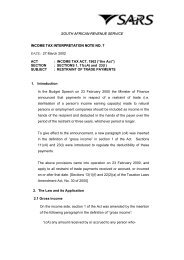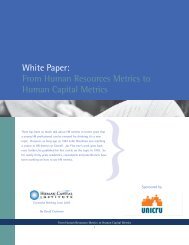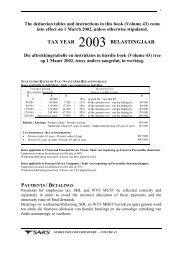The CEO's role in talent management - DDI
The CEO's role in talent management - DDI
The CEO's role in talent management - DDI
Create successful ePaper yourself
Turn your PDF publications into a flip-book with our unique Google optimized e-Paper software.
PROFILES<br />
<strong>The</strong> CEO’s <strong>role</strong> <strong>in</strong> <strong>talent</strong> <strong>management</strong><br />
How top executives from ten countries are nurtur<strong>in</strong>g the leaders of tomorrow<br />
Executive: Thierry Porte<br />
Title: President and Chief Executive Officer<br />
Company: Sh<strong>in</strong>sei Bank Limited<br />
Location: Tokyo<br />
CEO s<strong>in</strong>ce: 2005<br />
Age: 48<br />
Previous position: President, Representative<br />
Director and Branch Manager, Morgan Stanley<br />
Japan<br />
Sector: F<strong>in</strong>ancial services<br />
Revenue (2004): US$1.5bn<br />
“What we found <strong>in</strong> surveys of our<br />
employees over the last two years is that<br />
they are <strong>in</strong>terested <strong>in</strong> ongo<strong>in</strong>g learn<strong>in</strong>g as a<br />
way of enrich<strong>in</strong>g their own experience,<br />
develop<strong>in</strong>g their careers, deepen<strong>in</strong>g their<br />
knowledge and improv<strong>in</strong>g their skills,”<br />
Some chief executive officers use <strong>in</strong>novative<br />
strategies to upgrade <strong>talent</strong> <strong>management</strong>. When<br />
Thierry Porte became CEO of Sh<strong>in</strong>sei Bank, he<br />
thought the bank would benefit through the<br />
creation of a new position, Chief Learn<strong>in</strong>g Officer<br />
(CLO), to strengthen tra<strong>in</strong><strong>in</strong>g and development,<br />
especially for the bank’s senior executives. This<br />
was new ground for the Japanese bank. But Mr<br />
Porte looked at what a number of successful US<br />
organisations had done. He was also <strong>in</strong>fluenced<br />
by Harvard bus<strong>in</strong>ess school professor, Tom<br />
DeLong, who serves as a consultant to Sh<strong>in</strong>sei.<br />
<strong>The</strong> CLO works directly with Mr Porte and<br />
the head of human resources, who plays a more<br />
strategic <strong>role</strong> than <strong>in</strong> some companies and<br />
oversees other performance <strong>management</strong>related<br />
operations, <strong>in</strong>clud<strong>in</strong>g salary and benefits.<br />
“What we found <strong>in</strong> surveys of our employees<br />
over the last two years is that they are<br />
<strong>in</strong>terested <strong>in</strong> ongo<strong>in</strong>g learn<strong>in</strong>g as a way of<br />
enrich<strong>in</strong>g their own experience, develop<strong>in</strong>g their<br />
careers, deepen<strong>in</strong>g their knowledge and<br />
improv<strong>in</strong>g their skills,” says Mr Porte. “Learn<strong>in</strong>g<br />
takes a variety of forms. Some of that is<br />
<strong>management</strong> development. Some of that is<br />
leadership development.”<br />
Mr Porte took his position at a time of<br />
significant change. In 1998 the Japanese<br />
government nationalised Long-Term Credit Bank<br />
of Japan, and two years later sold it to USbased<br />
Ripplewood Hold<strong>in</strong>gs. Long-Term Credit<br />
subsequently changed names to Sh<strong>in</strong>sei and<br />
moved more <strong>in</strong>to retail bank<strong>in</strong>g. <strong>The</strong> company<br />
now offers such services as deposits,<br />
<strong>in</strong>vestments and mortgages, along with bond<br />
sales, underwrit<strong>in</strong>g and public sector f<strong>in</strong>ance.<br />
When he took his position <strong>in</strong> 2005, Mr Porte<br />
decided to shake up parts of the bus<strong>in</strong>ess. He<br />
abolished the seniority system and <strong>in</strong>stalled<br />
360-degree performance reviews. <strong>The</strong> company<br />
also began hir<strong>in</strong>g more aggressively from<br />
outside the bank. About 10% of Sh<strong>in</strong>sei’s<br />
workforce are recent university graduates who<br />
jo<strong>in</strong>ed the firm after the creation of Sh<strong>in</strong>sei, Mr.<br />
Porte says. Another 40% of staff are mid-career<br />
hires. <strong>The</strong> rema<strong>in</strong><strong>in</strong>g employees were Long-<br />
Term Credit bankers.<br />
Sh<strong>in</strong>sei has cont<strong>in</strong>gency and longer-term<br />
succession plans. Once a quarter, Mr Porte<br />
expects to discuss succession and performance<br />
development with an <strong>in</strong>ner circle of about 15<br />
executives. He also reviews both areas regularly<br />
with his board.<br />
Sh<strong>in</strong>sei Bank’s performance evaluations<br />
score employees <strong>in</strong> leadership and other<br />
categories and <strong>in</strong>corporate written feedback.<br />
<strong>The</strong> bank offers a range of formal development<br />
programmes. <strong>The</strong>y <strong>in</strong>clude classroom work, <strong>role</strong><br />
play<strong>in</strong>g and test<strong>in</strong>g. <strong>The</strong> bank tries to target<br />
specific skills and issues <strong>in</strong> each activity. Mr<br />
Porte said that Sh<strong>in</strong>sei <strong>in</strong>tends to add<br />
programmes, some managed <strong>in</strong>-house but<br />
others directed by outside consultants. Mr Porte<br />
plans to teach a leadership course that will meet<br />
once a week and run eight to 12 weeks. He<br />
envisions other Sh<strong>in</strong>sei executives teach<strong>in</strong>g<br />
similar classes.<br />
Sh<strong>in</strong>sei will also provide more opportunities<br />
for promis<strong>in</strong>g employees to pursue an MBA and<br />
shorter two- to three-month programmes. Two<br />
Japanese organisations, Hitotsubashi and<br />
Globis, enable workers to schedule classes after<br />
work. Mr Porte believes that these programmes<br />
help personnel to improve their skills and create<br />
network<strong>in</strong>g opportunities.<br />
Mr Porte spends 15-20% of his time on <strong>talent</strong><br />
<strong>management</strong>. He is responsible for the<br />
development of employees throughout Sh<strong>in</strong>sei<br />
Bank. “Very specifically [my responsibility] is to<br />
work with the senior team <strong>in</strong> develop<strong>in</strong>g their<br />
capabilities but also to assist them <strong>in</strong> com<strong>in</strong>g up<br />
with ideas, concepts, procedures, policies, to<br />
develop their workforce all the way through the<br />
organisation,” he says. “It is one of the most<br />
important th<strong>in</strong>gs I can do.”<br />
Sometimes foreign executives have difficulty<br />
manag<strong>in</strong>g employees because of cultural<br />
differences. Policies and programmes that may<br />
be just right <strong>in</strong> one country may be a poor<br />
choice <strong>in</strong> others. Communication can be tricky.<br />
That can be tricky, especially <strong>in</strong> Japan, which<br />
has long-stand<strong>in</strong>g bus<strong>in</strong>ess traditions. Mr Porte<br />
says that he has been careful about the changes<br />
and programmes he has pursued.<br />
Among Mr Porte’s biggest challenges is<br />
communicat<strong>in</strong>g the importance of <strong>talent</strong><br />
<strong>management</strong>. “I’m mak<strong>in</strong>g sure that it’s not just<br />
someth<strong>in</strong>g that people see as a burden but really<br />
as an opportunity both for personal growth as<br />
well as for a contribution to the company.” He<br />
adds that it is also important to <strong>in</strong>stall<br />
programmes that are right not only for a<br />
Japanese company but also to help his firm’s<br />
foreign employees. “We are work<strong>in</strong>g very hard<br />
to create th<strong>in</strong>gs that fit <strong>in</strong>to the context of<br />
Japan,” he says. “We have to have th<strong>in</strong>gs that<br />
actually work here and that’s an area where<br />
we’re creat<strong>in</strong>g the content ourselves.”<br />
36 © <strong>The</strong> Economist Intelligence Unit 2006

















